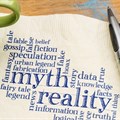
Questions to help you uncover fake news
In Vorster’s ‘future-proofing decision-making’ analogy, one piece of a puzzle is meaningless on its own: you cannot discern the big picture. It is only when you are able to connect that one piece of the puzzle with other pieces of the same puzzle that the big picture emerges. Conversely, if you’re unable to connect that single puzzle piece to others, you may realise the piece is actually part of a completely different puzzle.
Blurred, complex, exponentially multiplying puzzles
Future-proofing decision-making for a marketing strategy works in the same way: marketing based on one piece of a ‘puzzle’ – be it your market, brand, or product – is ineffective. With a boom in the number of accessible data sources and the resulting flood of data, the puzzle has become bigger, and rather than clearer, it has become more blurred and the puzzle pieces more complex. The number of puzzles is also multiplying exponentially.

Says Vorster: “In reality, the marketing puzzle is never complete, and in many instances the picture in the puzzle changes, sometimes slower and sometimes faster, and sometimes so completely that it might as well be, and usually is, a completely different puzzle than the one you thought you were building. The future of marketing strategy lies in identifying as many puzzles as possible, making connections between the pieces of the puzzle, and identifying in time when the puzzle has changed or will change completely.”
That’s because marketing decision-making is a delicate and deliberate combination and integration of science and art – with the emphasis on combination and integration. Not unlike puzzle pieces, the one is rendered useless and ineffective without the other, explains Vorster.
This proliferation of data sources and the complexity of data coupled with the pace of the use of information, as well as technological advancement and more have created the perfect storm for the evils that plague marketing, and society in general: lies, fake news and propaganda – and the line between these is fine because their mechanism, if not in their intent or purpose, is very similar.
Vorster says that addressing any one of these ills requires a significant effort to self-regulate on the one hand, and to inform and educate audiences and markets on the other. A good starting point therefore is learning how to spot lies, fake news and propaganda. In essence, ways of spotting these three things are virtually identical. Vorster says propaganda is not new and has been researched extensively. We can shortcut to a solution by applying the findings and insights about propaganda to fake news and lies as well-described tactics that are signs of propaganda evidently also apply to fake news.

Vorster says the mere fact that the term “fake news” exists indicates that there are indeed ways to identify news as fake. To address the issue of fake news, she says one could borrow from the traditions of both market research and journalism, using triangulation from research to rely on more than one source of information using more than one methodology, and second source support/confirmation from journalism as a way to future-proof decisions. Nothing does a brand more damage than being suspected, accused or found guilty of creating fake news: it really is a short-sighted, self-defeating practice in the short and medium term.
Seven questions to ask when evaluating whether news, or information and data, is fake:
- Who is the source? This includes finding out if the source and indeed the author actually exist, and if so, what their mission, purpose or agenda is. Are they credible and do they have a good reputation for quality information? Is there income derived from clicks/visits?
- Are there other original sources that corroborate the information? Find at least one additional source that supports the information that is not just parroting the source in question. A retweet on Twitter and a repost or share on Facebook does not corroborate the information contained in it.
- When was the information published? This gives context to the information. For example, anything published on 1 April should be carefully considered these days.
- How absurd is the story on a scale of 1 to 10? Good old common sense can sometimes spare us from embarrassment, by recognising satire, for example.
- What are my own biases, and is the content triggering them? What emotions are deliberately evoked by the author? Is the information presented in an inflammatory way?
- What do the experts say or think about the content, independently from the source?Is the information well presented? For example, poor editing and informal style in what is supposed to be a formal publication should raise a number of flags.
Similarly, marketers should also ask these questions when they are working with data and information about their brands, products, customers and more.
Vorster ends with a note that while data analytics to understand a market, evaluate marketing and engage consumers, is important, keep in mind that “a data analytics tool or supplier that sources all information from one source, or that over-simplifies the meaning in data, is like a reader who reads just one news site, and who only reads headlines, not whole stories.”
We all know how outrageous headlines can be, especially in a click-seeking culture. Once you have established that the source of information is credible and representative for your specific needs, target group, brand and more, Vorster reminds us that detailed text and sentiment analysis are key components of meaningful analysis, especially for marketing purposes.
Follow @SAMRA_CEO for the latest updates!
About Leigh Andrews
View my profile and articles...